It’s day 6 of a one week visit to Uzbekistan and I’m on the Afrosiab train criss-crossing the country from Bukhara to Tashkent via Samarkand. I could be on Amtrak except that the landscape is different – first desert-like, now more trees and lots of black cows, brown and white horses and occasional herds of goats. I see people picking cotton in the fields. Oh, and there’s the added benefit that the train staff keeps coming by to offer tantalizing treats – fresh fruit cups, strawberry or vanilla ice cream, and a cart loaded with snacks like Pringles, Lays, and Milka chocolate.
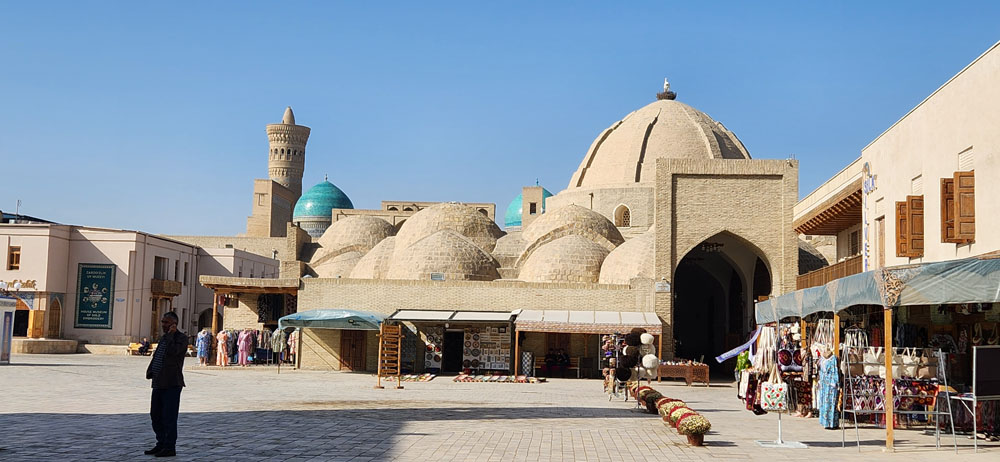
My husband asked me earlier today, “was Uzbekistan what you expected?” I am not completely sure how to answer this. In some ways, yes – I expected the stunning blue tiled madrassahs, mosques, and mausoleums reminiscent of pictures from Iran.
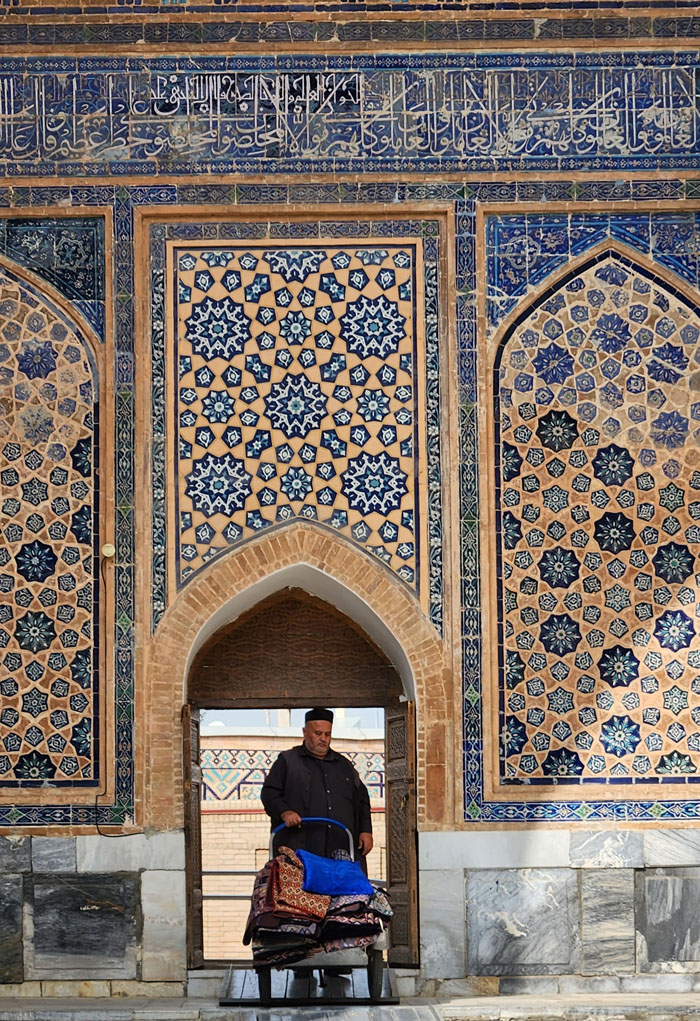
I expected the meat-centric cuisine and that there would be far fewer tourists here than most other places we’ve visited. (We didn’t encounter any Americans, but groups of French, Spanish, Italians, Germans, Israelis, and Russians.) And I expected that compared to the Arabian peninsula where we have just spent 2 weeks, this predominantly (but secular) Muslim country would be a bit less outwardly religious.
But there were plenty of surprises as well.
Uzbekistan is a magical land full of stories and legends about kingdoms won and lost (it has been conquered and rebuilt countless times over 2500 years). It may sound blasé, but It’s a bit like a fairytale movie set in a remote place with dervishes and emirs and other fascinating creatures whose stories live on to this day.
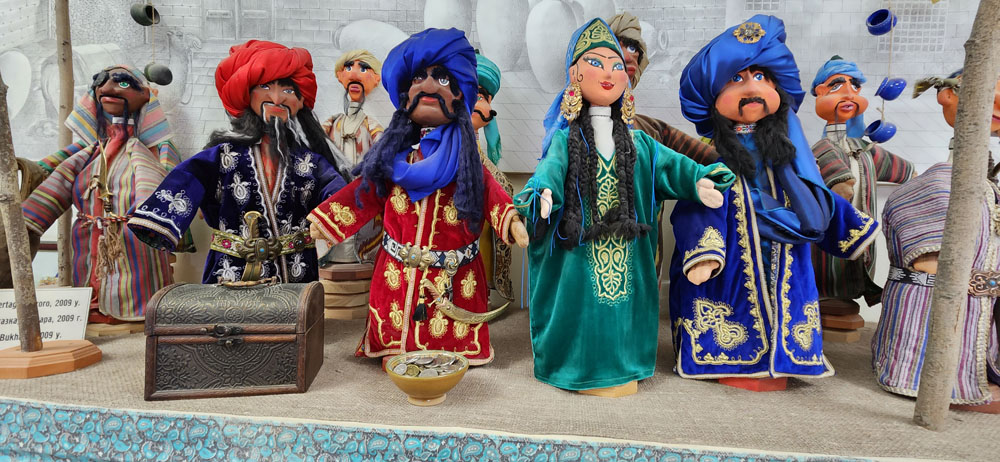
The items for sale at the bazaar still reflect this fantastical world. There are scissors shaped like long-necked cranes, brightly colored silk robes for men and women, unique squarish headwear called karakul, pounded copper plates, embroidered cotton clothing and tablecloths with pomegranate motifs, clay birds that whistle, silk carpets, camel hair socks, heavy silver jewelry, boldly-patterned tea sets with gold, miniature paintings which depict legends, and so much more.

A historical and explanatory note about this from my friend Karl who had travelled to Uzbekistan as well. “all the people in the surrounding countries were nomads, living off the land and moving when depleted. In Uzbekistan they were always mainly traders, possibly through the geography, which brought goods from China and eventually through the Silk Road and on to Turkey and eventually Venice and Europe. They remain the same traders today.”
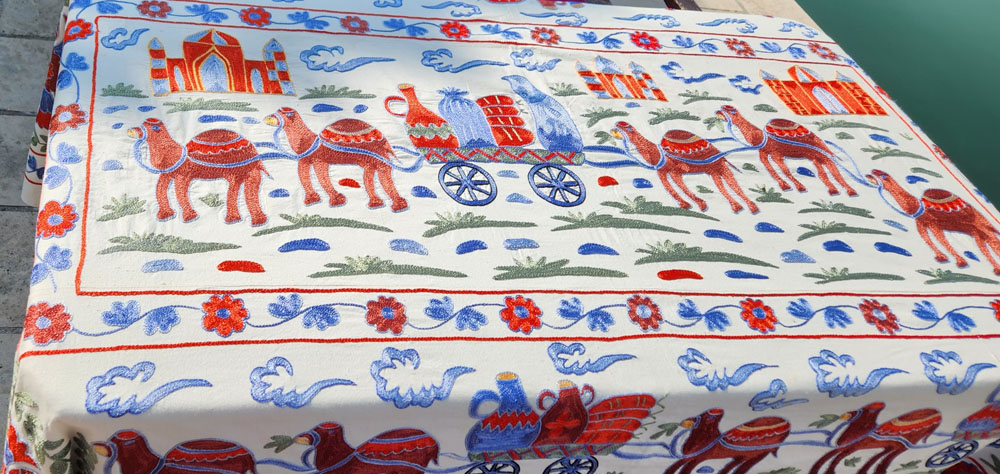
But here’s the thing I found most wonderful about Uzbekistan. I was able to go back in time. Which I love to do. Here is a place where men (called “suitors”) court women in traditional ways, where schoolboys dress in suits, where even after a hard bargaining session in the bazaar, you leave smiling as friends. Traditions are deeply rooted in the culture and honored to this day.
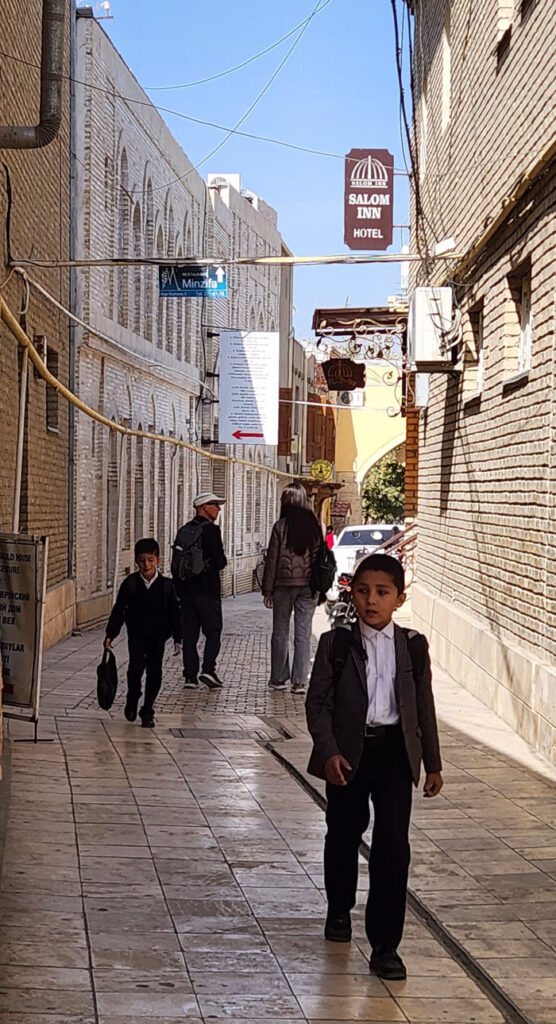
This “old world” way of living showed up in how we were treated. In the bazaar, we were offered tastes of everything – free reign to just dig in and take whatever we wanted! At the spice stall, I was asked what I cook most often at home and then a custom spice blend was created for me. I felt like it was a honor for others to take good care of me in Uzbekistan. For example, at breakfast in our small hotel in Samarkand, we were treated so attentively – including a “just for us” batch of fresh hot srinecky (delicious farmer’s cheese pancakes). On our first morning, we lingered in the breakfast room after an exhausting all-night flight. Only later did we learn breakfast ends at 10am and we were there well past 10:30. No one dared to say a word to us about this timing for fear of spoiling our breakfast experience. The food stayed out, the coffee was refilled. They just worked late that day. By comparison, in Seoul, breakfast also ended at 10am. At precisely 10am, the buffet was dismantled in about 2 minutes. It didn’t matter that we were still eating or trying to get one more cappuccino.
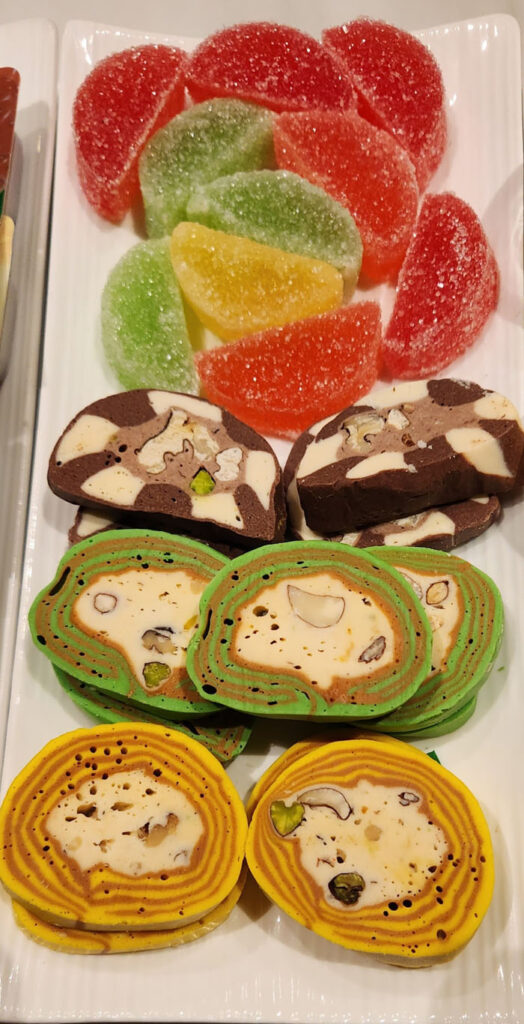
Uzbekistan is also very safe. When it was nearly time to board our train to Bukhara, we were told to just leave our suitcases and backpacks outside on the platform while we went back inside to stay warm and browse the station store – because no one would dare to take someone else’s stuff. Can you imagine just leaving all your belongings on a train platform?
People take enormous pride in traditional culture and local handiwork. We saw and experienced so many types of crafts – a puppet workshop, copper and brass hammering, rugs being hand stitched in silk or camel wool, a tea house offering the traditional tea ceremony with local sweets, the painting of miniatures, Suzane (gorgeous Bukharan embroidery), and wood carving. And we were enthusiastically encouraged to participate; we created our own ceramic plates, we baked traditional Uzbek bread, we ate 3 different variations of Plov and even helped to make it ourselves!
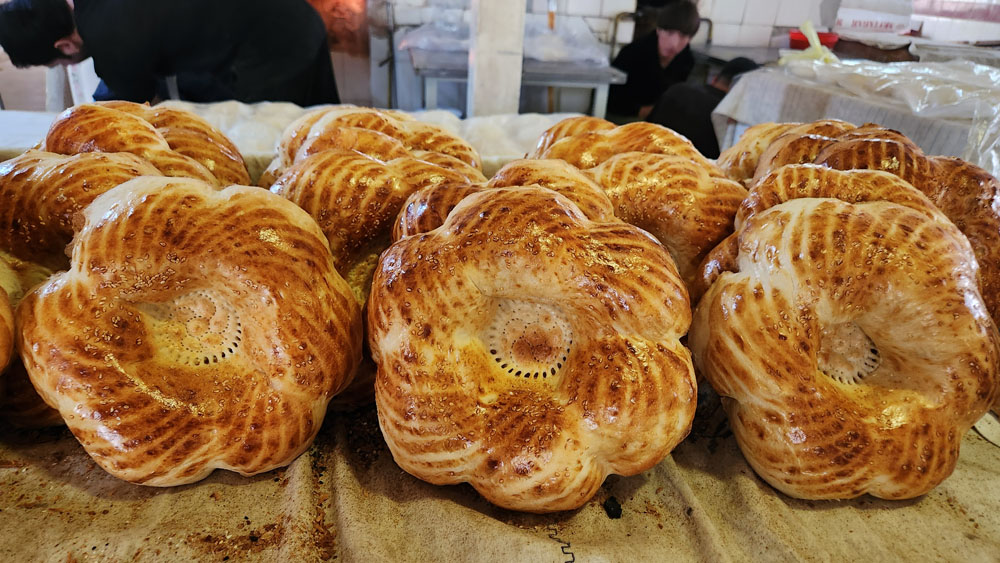
A word about Plov. Uzbekistan is very proud of Plov. It’s is the national dish and most closely resembles rice pilaf with meat and vegetables. Each region features a variation. In the tiny hamlet of Mingbulok, we were served our first taste of Plov by a local family. This meal followed a hike (and donkey ride!) in the local Zarafshan mountain chain. After this outing, we were ogled by the neighborhood kids who were headed home from school for lunch. Apparently fair skinned and blue-eyed Americans are not a common sight in the Uzbek countryside. This also may have explained why the husband wanted to swap wives with Bruce!
Anyway, back to Plov. Lunch was served in a typical village home situated on a sizable plot of land containing a large vegetable garden and 3 cows (offered as part of the wife swap). This “Samarkand” version of Plov featured rice, beef, yellow peppers, and lemon slices.
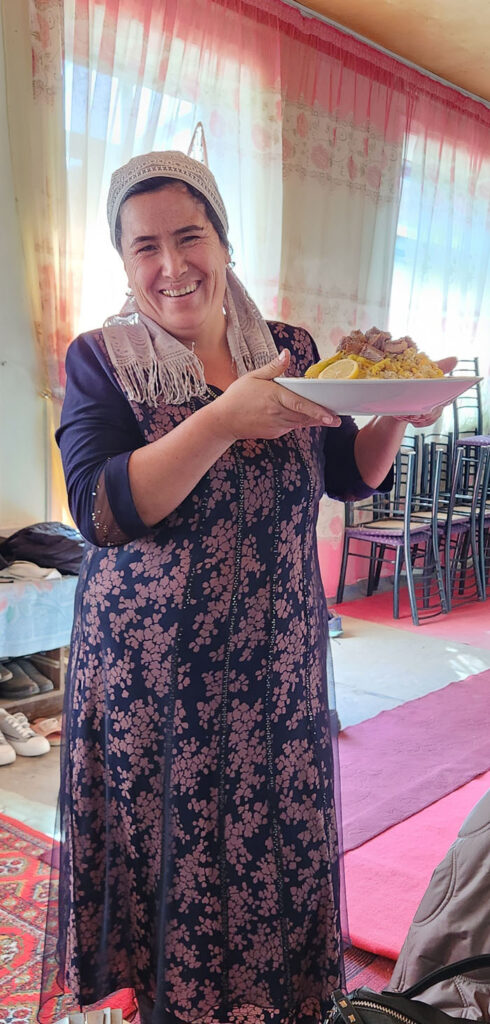
In Bukhara, I got to assist in Plov-making with a master chef. The Plov cooks in a huge special pot called a Kazan. Here we seared beef in 5 different kinds of oil, including almond oil. Then we layered on onions, whole heads of garlic, thick yellow and orange carrot matchsticks, and quince. This bubbled along for about 90 min before rice was added and then raisins and quail eggs. The whole delicious thing was finished off with tangy yogurt and fresh bread.
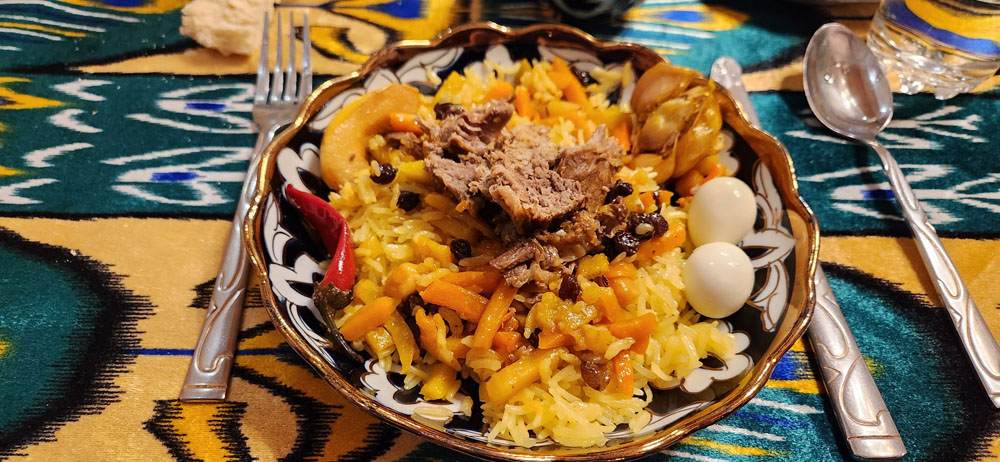
In Tashkent, we tasted our final version of Plov at the Plov Center where, it seems, everyone comes to eat their Plov! Similar to the other versions but slightly different, we enjoyed it with fresh tomato salad to help mitigate the richness of the dish and with hot tea to help with digestion.
It’s time for me to move on to Korea but I have a feeling Uzbekistan will be on my mind for a long time. I’m going to sign off by placing my right hand over my heart, as Uzbeks do, to show respect and indicate “peace be upon you.”
And there’s more after the next picture.
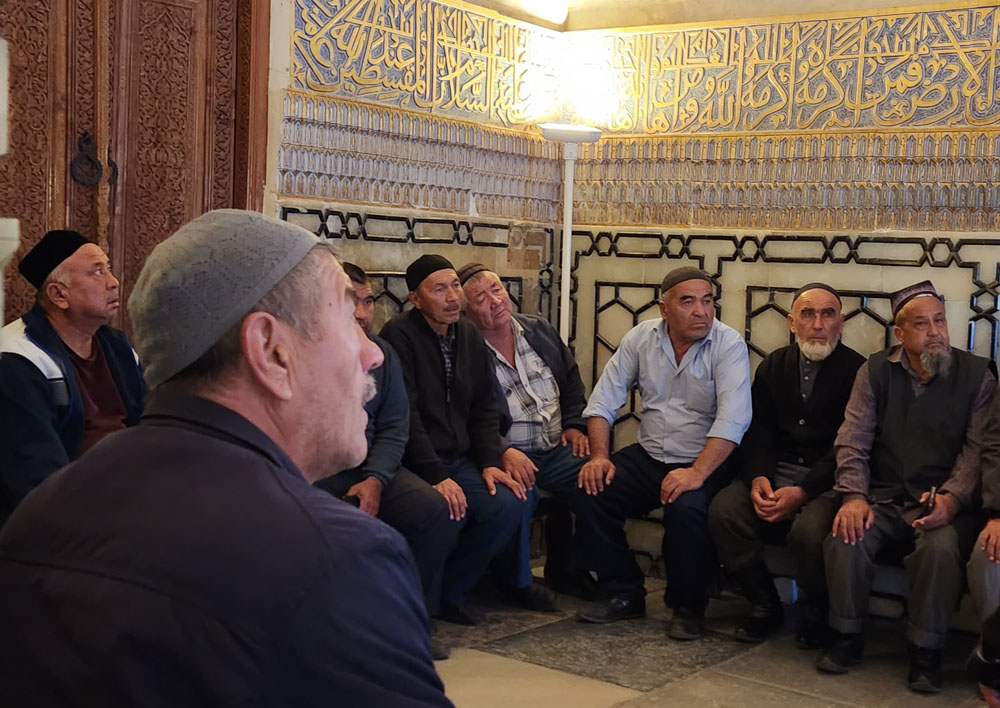
I thought it might be interesting to share some additional perspective from our Uzbek guide, Kami. Read on to hear from a native!
—————————————————————————————————————————————
Meet Kamola (Kami)!
She speaks Uzbek, Russian, Mandarin, and English fluently and hails from Tashkent, Uzbekistan.
Kami taught English for 9 years, beginning when she started at the University in Tashkent for a BA in Chinese/Oriental Studies. She has been a guide for just over a year after getting her Masters in Tourism (a 2 year program during covid!) at The Silk Road International University of Tourism and Cultural Heritage. Kami grew up in a single parent home; her mother is an epidemiologist who teaches histology at a medical university. Starting in 2nd grade, she took care of herself after school and until her mother returned home from work; this is common, she claims. She likes Paprika-flavored Pringles ($5 per tube locally), has many “suitors”, and strong opinions on how Plov should be prepared. I asked her the following questions on our 4 hour train ride from Bukhara to Tashkent.
A: What is the biggest misnomer about Uzbekistan?
K: That we are like Pakistan or Afghanistan. Also, that we are part of eastern Europe – we are NOT!
A: What are you most proud of in your heritage?
K: Our rich culture and tradition such as manners, way of life, our respect for each other and especially for elders. We think about consequences like not hurting others, caring for others and being hospitable.
A: What do your tour guests like most-about Uzbekistan?
K: The food and Samarkand. (Specific food she mentioned includes lagman – a tasty noodle dish, plov, somsa which is like a knish or samosa, bread, and the soups. Kami is quick to say that Uzebekistan is NOT for vegans, vegetarians or gluten-free types. They should “bring snacks”!
A: What do guests incorrectly assume about the country?
K: They are so stressed about leaving luggage out and pickpockets – this is not an issue here. Also they worry that it’s not safe to go out without a guide – not true!
A: What is one thing not to miss if one travels to Uzbekistan?
K: Samarkand -because it is a combination of historical places and a modern city
A: Who are your favorite people to guide?
K: Americans because they are friendly, supportive, and open minded (the exception was one group of Texans who were high maintenance, always complaining and shouting!)
A: If you were to travel outside Uzbekistan, where would you like to travel to?
K: Italy and France
A: Where do you see yourself 5 years from now?
K: married and still a tour guide “I’m in love with my job” – I like to work with different kinds of people. (marriage age in Uzbekistan is mostly between 18-22 and it’s typical to then live with family members or your in-laws if you are female.)
A: What do you hope for the future?
K: That Uzbekistan will develop more and it will become easier for tourists to travel here. Also, ramps for disabled people to make it more convenient for them.
A: What’s a rule that you follow in your tourism company?
K: We don’t discuss politics.
A: What is the longest amount of time you’ve spent outside Uzbekistan?
K: I had a one year scholarship to study Mandarin and lived in the Chinese city of Tsing Tao (like the beer) in Shandong Province
Thanks, Kami!
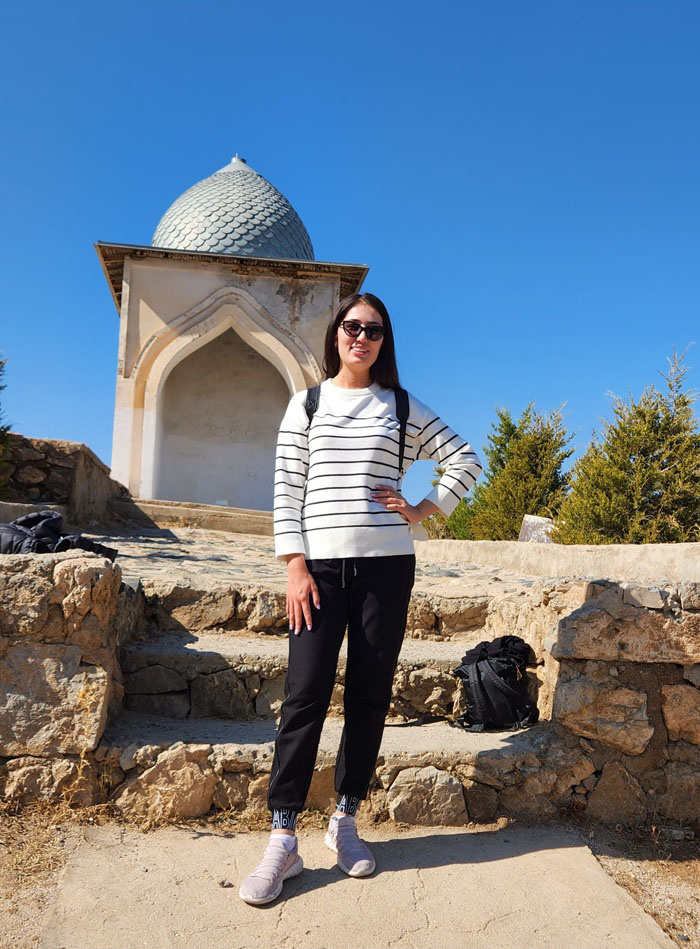
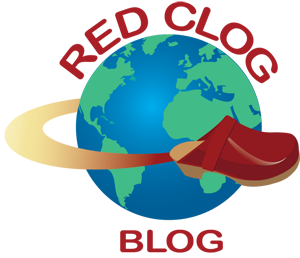
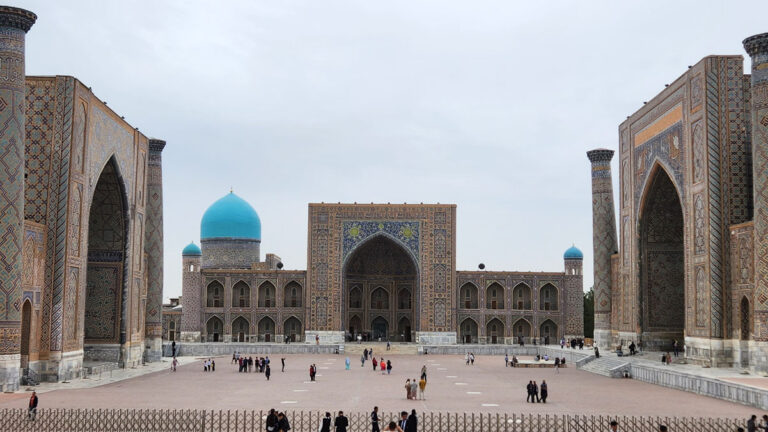
7 Comments
Always an adventure to visit new places with you . . . whether it’s in “Red Clogs” or in-person!!
Stay safe and continue to enjoy your incredible travels!! XOXOXO
So when are we going?
I am fascinated and intrigued. I would go in a heartbeat. Sign me up!
What an amazing adventure Alysa!! I loved reading about Uzbekistan as seen through your eyes. What fearless travelers you both are. Thank you for sharing this blog – sending you both love and safe travels back home.
Just a fantastic blog post! Almost felt like I was there!
Awesome reading as always!
Fantastical traveling with you! 🙏
it sounds like a wonderful exotic place. thank u.